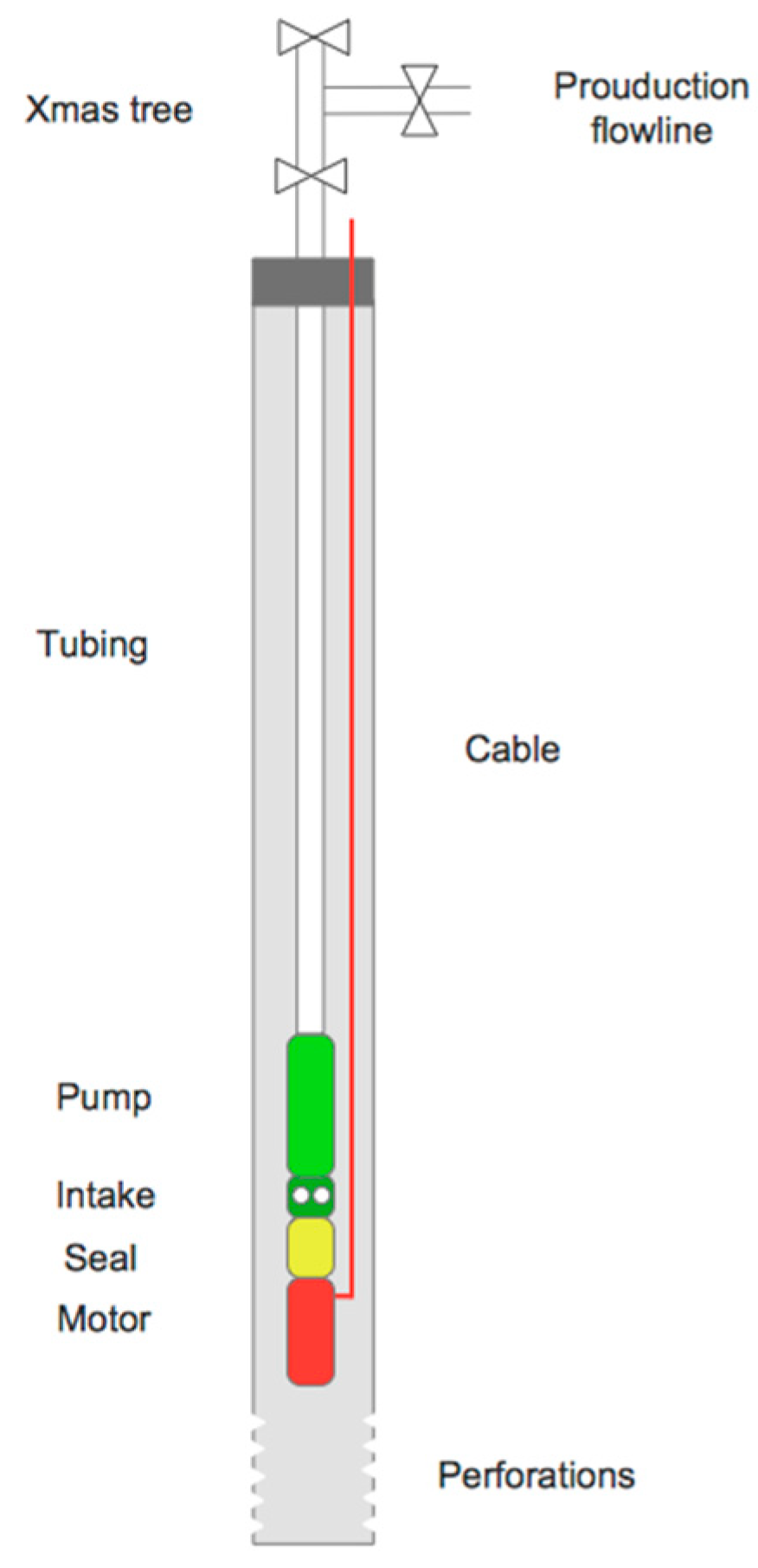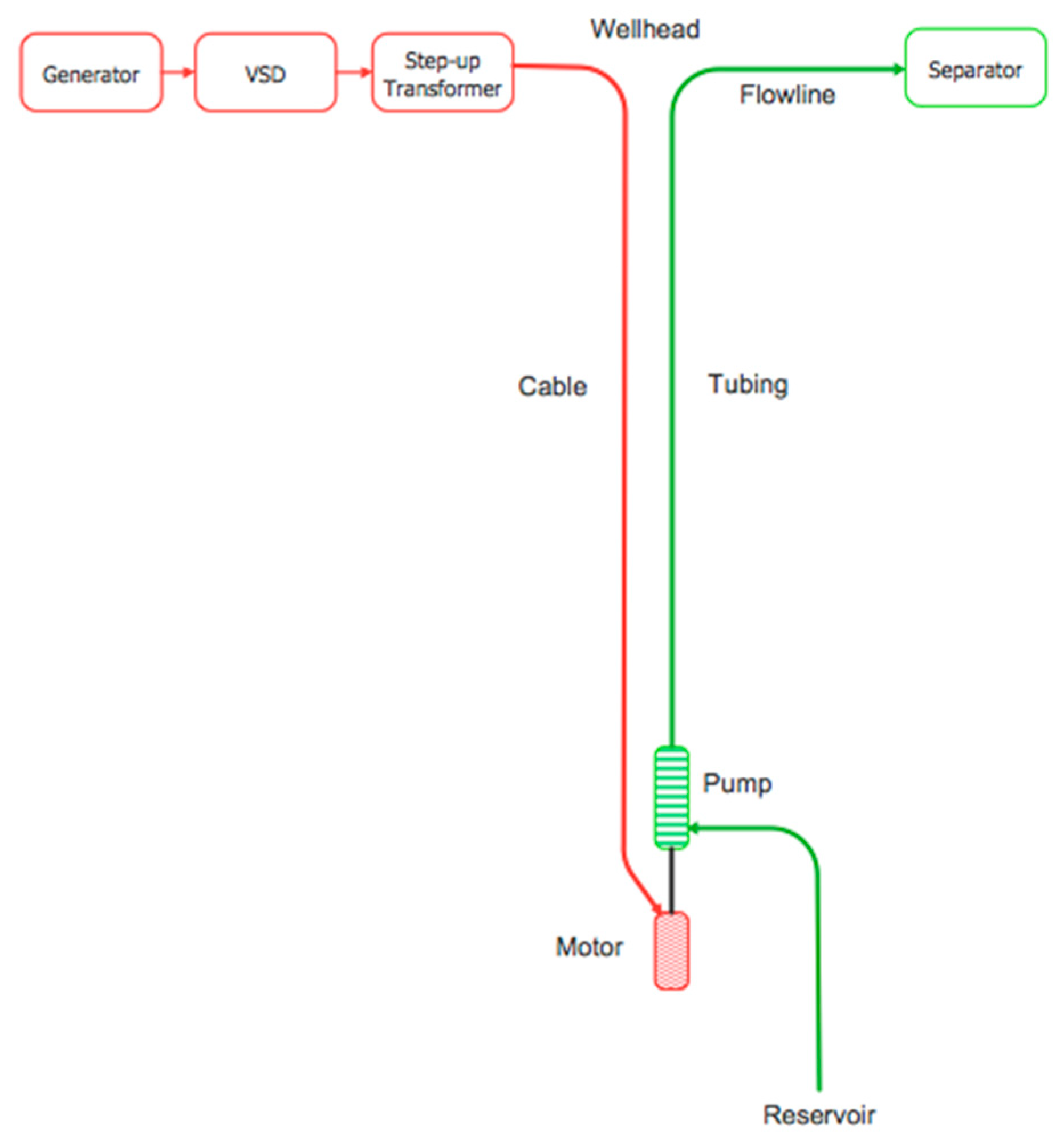The researchers have access to detailed data operational data from several offshore platforms located in South East Asia. The platforms tend to have 15 to 20 wells each, which are all equipped with electrical submersible pumps. One representative platform is selected for analysis, and a typical day’s data is evaluated from the year 2017. The selected platform has 18 production wells, which represent a wide range of operating conditions such as well depth, fluid properties, crude and water flowrates, and bottom-hole pressures. The methodology involves treating each production well as a separate energy accounting center, to facilitate comparisons between wells and to evaluate the factors that influence energy related parameters, such as the EROI and EI, and economic factors, such as the lifting costs. It should be noted that there are also 3 water disposal wells, which receive pressurized water from centrifugal pumps located on the platform.
Step 1: Development of EROI-Lifting and energy intensity for each well.
2.1. Energy Intensity
The energy intensity for lifting for each well, as shown in Equation (7), can be found by taking the inverse of the EROI
Lifting and multiplying it by the chemical energy per barrel of crude.
where:
Step 2: Development of lifting costs for each well.
Lifting costs were developed by converting the daily diesel consumption to a cost based on a diesel cost of 2.7 US dollars per gallon, which was the 2017 average cost of diesel. Therefore, the lifting cost for each well can be derived by multiplying the energy intensity by the energy costs as described in Equation (8).
where:
Step 3: Development of Detailed Energy Balances for each well.
This research involved an analysis of a set of ESPs from an actual offshore platform in order to gain a better understanding of the energetic behavior of ESP systems in an actual operating environment. A typical day was selected and data were retrieved from site via the distributed control system, the variable speed drives, and the transformer tapping arraignments. For step 3, the provided data and calculated data are shown in
Table 3. The actual data provided and calculated are contained in
Appendix A,
Table A3 and
Table A4 respectively.
A number of equations are employed to calculate an energy balance for each of the 18 ESP systems.
The overall electrical balance for each well is described by Equation (9).
where:
Surface power losses are calculated by taking into account the power factor of the surface equipment as indicated in Equation (10).
where:
Downhole cable losses are a function of the cable resistance, and the current as shown in Equation (11).
where:
Motor losses are calculated by multiplying the electrical power into the motor by the ESP motor efficiency factor, which is extracted from the motor efficiency curve, as indicated in Equation (12).
where:
The overall electrical power efficiency for each well is simply the brake power output of the motor divided by the power into the ESP electrical system as described in Equation (13).
where:
The overall hydraulic energy balance for each well is described in Equation (14).
where:
The hydraulic lifting power of the ESP pump is indicated in Equation (15).
where:
The total head in meters is calculated by taking into account the true vertical depth of the pump, as well as the surface backpressure converted to head as described in Equation (16):
where:
Frictional losses are calculated as per Equations (17) and (18).
where:
The hydraulic efficiency for each well is simply the hydraulic head required to uplift the fluids to the surface plus the energy required to overcome backpressure and friction divided by the brake power provided to the pump as shown in Equation (19):
where:
Finally, the overall ESP system efficiency can be calculated by multiplying the hydraulic efficiency by the electrical efficiency as described in Equation (20).
where:
2.2. Supplmental Electrical Equations
The relationship of flowrate, electrical frequencies and pumping speeds, head, and power is described by the pump affinity laws. The affinity laws state that the flow rate of the pump changes directly proportional to the speed, the head developed by the pump changes proportionally to the square of the speed, and the power required to drive the pump changes proportionally to the cube of the speed. The affinity laws are described by Equations (21)–(23).
where:
Since the power frequency is directly related to the motor speed, the affinity laws can be calculated with either the pump speed or the power frequency as described in Equations (24)–(26).
where:
It should also be noted that transformers are used to vary the voltage of an AC electrical source and work on the principle of electromagnetic induction. A transformer typically consists of an iron core and two coils of insulated metal wires. The incoming AC power is directed through the primary coils and the circuit to be powered is connected to the secondary coils. Alternative tapping points on the secondary coils can be used to select from a range of output voltages. The relationship between voltage, current, and the number of turns in the primary and secondary coils are shown in Equations (27) and (28).
where:
The frequencies of the electric currents in both coils are identical, but the currents will be different. The following formula is found for the relationship of current.
where:
Finally, it should be noted that the real electric power, typically designated in kW units, is found by considering the real current such that I
real = I
line*cos(
). For a three-phase power supply, Equations (29) and (30) can be used to determine the line power and the real power, respectively.
where:
These equations can be used to determine the power anywhere within the system if the current, voltage, and power factor are known.

















